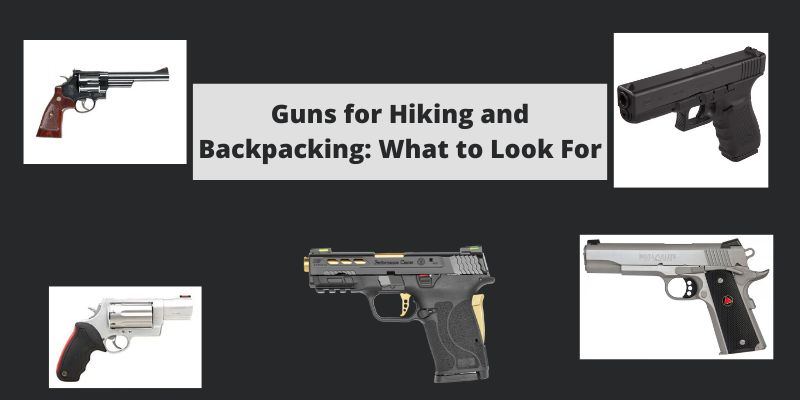When you’re out in the wilderness, there are a lot of things to worry about – food, water, shelter, and making sure you don’t get lost. One thing that is often overlooked is protection against wild animals, or other people with bad intentions. While it’s extremely rare to encounter a dangerous animal in a life-threatening way while hiking or backpacking, some feel more comfortable carrying a firearm. In this blog post, we’ll discuss what characteristics to look for when choosing a gun for hiking, backpacking, and general outdoor use, and then recommend some specific guns that fit the bill.
We also want to add a disclaimer that we are by no means saying that you must bring firearms to your outdoor adventure. In fact, if you aren’t comfortable with guns, you shouldn’t use them, period. But that said, we recognize that in some areas of the world, having a firearm for wildlife may be essential. In other areas, this may not be the case. This is up to the user’s discretion, and our aim with this article is to simply point out the factors you should consider when thinking about a firearm for hiking or backpacking. If you do decide to bring a gun with you, remember to be responsible. Always have your gun securely stored, and be aware of the limitations that come with gun carriage, as well as the legal requirements for firearm use in the areas you’re hiking.
What Makes A Good Hiking Gun?
Not all guns are good for hiking, and that includes the types of guns you might use for hunting. While plenty of compact handguns are used for hunting purposes, these are often heavy, with long barrels and more stopping power than you need while hiking. A gun for hiking is a gun for defense, not offense.
So what characteristics do the best hiking guns share? Here’s what you should be looking for when choosing a trail gun.
Light-Weight
When you’re hiking, every ounce counts. You want to be carrying the lightest load possible, and that includes your gun. Look for something lightweight – under three pounds is ideal. Some guns are designed specifically with hikers in mind, where they minimize weight without necessarily minimizing power. Finding the balance can be difficult with hiking since many deem it necessary to have a higher-powered weapon for defense against animals, making the weapon heavier than lower-caliber firearms.
A 22 or a 9 millimeter compact firearm will be lightweight, but will have less stopping power.
Compact
You also want your gun to be as compact as possible, since you’ll likely be carrying it in a backpack or on your hip. Again, many manufacturers have begun making guns specifically for hikers and backpackers – they’re often called “trail guns.” These are designed to be small and easy to carry, without sacrificing power.
Having a compact weapon will make packing it much easier. This characteristic is really up to personal preference. If open carrying on the hip, the size may be of less concern as long as it isn’t getting in the way of trekking poles or other items.
Powerful
A gun should be powerful enough for protection from animals. Guns that aren’t suitable for protection from big animals like a bear may not be suitable for hiking. Simply put, the less power a firearm has, the more difficult it would be to stop danger quickly and abruptly. Having a 9mm or smaller weapon is great for compact and lightweight carrying, but when it comes to stopping a bear, moose, or other large animal, it will take some impeccable shots in a very stressful situation.
When thinking about stopping power, it’s vital to know your potential threats. Canines like feral dogs (way more dangerous to humans than coyotes!) or even a feral hog will likely be deterred by a lightweight .22 or a 9-millimeter compact firearm. But if you’re in big bear country (think grizzlies/brown bears or polar bears in Alaska), you need a larger firearm. If this is a risk for you, consider a bigger caliber, like a .40 or above.
Easy To Carry
When there is walking on uneven or mountainous trails involved, a gun that can be carried with ease is very important. Bulky weapons that require a lot of space and effort to lift are unsuitable for hiking. In defense situations, you want a firearm that can be operated with one hand. You also want a weapon that allows you to hike comfortably. For instance, looking for a shorter barrel in the 3-6 inch range is likely a better choice.
Comfortable to Shoot
A gun that you’re afraid to fire is just dead weight. If you’re going to hike with a gun, you absolutely must be comfortable firing that weapon. Don’t let the first time you fire be a dangerous situation. Get comfortable and familiar with your gun at a range. Learn about all of the different parts, and know how to take it apart, clean it, and put it back together. Practice shooting until you have a decent degree of accuracy. Some threats can be scared off by just the sound of shooting, but others won’t. Don’t think that just having a gun will protect you.
Fortunately, if you’re in the United States, there’s very likely to be a gun range within a few miles of your home. Many of these ranges offer safety classes, like the NSSF First Shots program designed for new shooters. Check with the store where you purchased your gun to see what kind of gun classes they offer.
To Revolve, or Not To Revolve?
Revolvers can be a controversial choice for a trail gun. There are two main reasons for this: resistance to dirt and resistance to cold.
Revolvers have more moving parts than your average pistol, and the cylinder is exposed to the elements. For most hikers, this isn’t a problem. However, if you’re hiking somewhere with fine dirt or sand and high winds, you may run into issues with grit getting into the crevices of your revolver. You can bring a cleaning kit with you, but that does take additional weight and space. A better solution for revolver fans is to keep the gun covered and prevent sand from getting in there in the first place. You can also apply a synthetic light grease to your gun, which works a bit like Teflon and helps grit slide right off.
Another problem with revolvers is the cold. In extremely cold temperatures, a revolver’s cylinder may lock up, which means the gun won’t shoot. This can be a big problem, especially if you’re worried about big animals that like cold weather– think moose and bears. If you know you’re going to be hiking a lot in cold conditions, it’s better to choose a different type of handgun to avoid this risk.
Revolvers can be amazing trail guns. Some of them have great stopping power and are easy to shoot. Their lack of magazines can save weight, and they can have a lot of oomph for a relatively compact size. But everybody’s hiking situation is different, so consider the environment you hike in the most when deciding whether or not to use a revolver.
Top Hiking Guns To Choose
Keeping in mind all the above considerations, we have hand-picked and created a list of the best guns for hiking. Based on the criteria listed above, these firearms cross off all, or a few of the list. This is by no means a complete list, but is a good starting point for your research. In this list, you’ll notice a couple of key items:
- The firearms listed have a caliber above 9mm, and often have several options for caliber.
- The firearms have a small and compact profile
- The firearm is considered widely as reliable, durable, and can handle dirt, water, and other debris
- The firearm is from a reputable brand
Glock G20
 The very first gun on our list is the versatile Glock G20. It is not heavy, i.e easy to carry, which is a must for hiking. It can fire 15 rounds of 10mm, which means it is powerful enough to incapacitate even bears and does not run out of ammunition easily. Moreover, since Glock is easy to customize, you can look into the various Glock accessories available in the market to suit all your requirements. Overall, this is one of the best more modern options due to capacity, stopping power, and relative size/weight compared to other 10mm weapons.
The very first gun on our list is the versatile Glock G20. It is not heavy, i.e easy to carry, which is a must for hiking. It can fire 15 rounds of 10mm, which means it is powerful enough to incapacitate even bears and does not run out of ammunition easily. Moreover, since Glock is easy to customize, you can look into the various Glock accessories available in the market to suit all your requirements. Overall, this is one of the best more modern options due to capacity, stopping power, and relative size/weight compared to other 10mm weapons.
Barrel Length: 117 mm | 4.61 inch
Caliber: 10mm Auto
Weight with loaded magazine: 1130 g | 39.86 oz
Mag. Capacity: Standard: 15
View On Guns.com | View On Glock | View On Cabela’s
Smith And Wesson 29
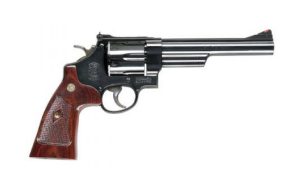 The Smith and Wesson 29 is a .44 magnum double-action revolver. It is compact, it is extremely reliable and carries tons of stopping power. This isn’t the smallest gun, but it be carried quite easily. Note that .44s are quite powerful and have a lot of kick; this is definitely one to practice with before taking it out on the trail!
The Smith and Wesson 29 is a .44 magnum double-action revolver. It is compact, it is extremely reliable and carries tons of stopping power. This isn’t the smallest gun, but it be carried quite easily. Note that .44s are quite powerful and have a lot of kick; this is definitely one to practice with before taking it out on the trail!
Caliber: 44 Magnum, 44 S&W Special
Capacity: 6
Barrel Length: 6.5″ / 16.5 cm
Overall Length: 12.0″
Mag. Capacity: Standard: 15
Weight: 45 ounces
View On Guns.com | View On Smith & Wesson | View On Gun Broker
Colt Delta Elite
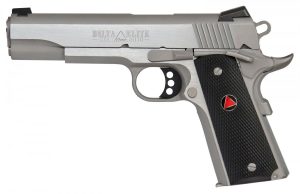 Another excellent choice for hiking, the Colt Delta Elite also fires bullets of 10mm and is potentially fatal for most small animals. It can fire 9 rounds and is easy to hold in your hand.
Another excellent choice for hiking, the Colt Delta Elite also fires bullets of 10mm and is potentially fatal for most small animals. It can fire 9 rounds and is easy to hold in your hand.
Barrel Length: 5″ / 12.7 cm
Caliber: 10 mm
Mag. Capacity: 8+1
Weight: 38.4 ounces
View On Guns.com | View On Colt | View On Gun Broker
Taurus 513 Raging Judge Ultralite
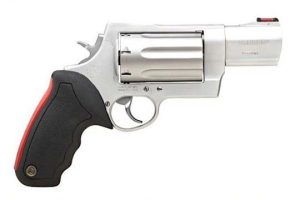 This compact revolver packs a .45 Colt caliber. The Raging Judge has several sizes available, including the compact 3-inch barrel with a 7-round capacity. This smaller revolver packs an enormous punch and gives hikers the protection of larger weapons at a much smaller size. It can be a little awkward to holster given its dimensions, but if it’s stopping power you want, the Raging Judge might be the gun you need.
This compact revolver packs a .45 Colt caliber. The Raging Judge has several sizes available, including the compact 3-inch barrel with a 7-round capacity. This smaller revolver packs an enormous punch and gives hikers the protection of larger weapons at a much smaller size. It can be a little awkward to holster given its dimensions, but if it’s stopping power you want, the Raging Judge might be the gun you need.
Barrel Length: 3”/7.62 cm
Caliber: .45 Colt
Capacity Standard: 7
Weight: 41.4 ounces
Ruger American Pistol Compact
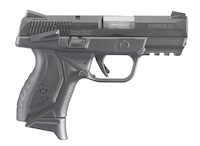 Ruger makes incredible guns. The American is a classic and well-respected firearm that comes with several caliber sizes, a compact size, ease of use, and great reliability. For hikers, the 9mm or the 45 caliber are great compact and lightweight options.
Ruger makes incredible guns. The American is a classic and well-respected firearm that comes with several caliber sizes, a compact size, ease of use, and great reliability. For hikers, the 9mm or the 45 caliber are great compact and lightweight options.
Weight: 28.6 oz. (45 caliber)
Overall Length: 7.25″
Height: 4.65″
Barrel Length: 3.55 inches / 9 cm
Caliber: .45 or 9mm
Capacity: 17+1
View On Guns.com | View On Ruger
Ruger Blackhawk
 This Ruger revolver comes with several caliber options, weighs less than 3 pounds, and has a relatively short barrel option making it extremely versatile and durable for outdoor situations.
This Ruger revolver comes with several caliber options, weighs less than 3 pounds, and has a relatively short barrel option making it extremely versatile and durable for outdoor situations.
Barrel Length: 4.62″
Overall Length: 10.50″
Weight: 42 oz.
Caliber: Varied; we’re describing the .45 here.
Capacity: 6
View On Guns.com | View On Ruger | View On Bass Pro Shops
Smith & Wesson M&P Shield EZ
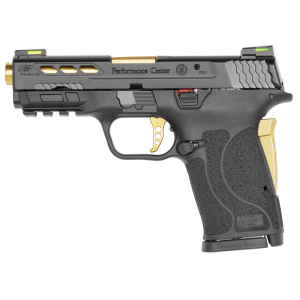 The Shield is known as one of the most reliable, low-cost, and durable 9mm pistols. The ultra-compact and lightweight size make for a great firearm for many outdoor situations, although this isn’t the gun you want to tote in bear country. For smaller threats, it definitely fits the bill.
The Shield is known as one of the most reliable, low-cost, and durable 9mm pistols. The ultra-compact and lightweight size make for a great firearm for many outdoor situations, although this isn’t the gun you want to tote in bear country. For smaller threats, it definitely fits the bill.
Caliber: 9mm Luger
Capacity: 8+1
Barrel Length: 3.8″ (9.7 cm)
Weight: 23.2 oz.
View On Guns.com | View On Smith & Wesson
Glock 17
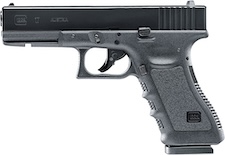 Another great Glock is the Glock 17. It is preferred by law enforcement for its ease of carry, its reliability, and its imperviousness to outdoor elements. Moreover, it can be customized to suit the shooter through its various accessories, such as Glock magazine base plates, grip plugs, and Glock gunsmith tools. Glocks bring to the table extreme durability, large magazines, powerful caliber if needed, and overall great ease of use.
Another great Glock is the Glock 17. It is preferred by law enforcement for its ease of carry, its reliability, and its imperviousness to outdoor elements. Moreover, it can be customized to suit the shooter through its various accessories, such as Glock magazine base plates, grip plugs, and Glock gunsmith tools. Glocks bring to the table extreme durability, large magazines, powerful caliber if needed, and overall great ease of use.
Glock’s bring to the table extreme durability, large magazines, powerful caliber if needed, and overall great ease of use.
Caliber: 9mm
Weight with loaded magazine: 915 g | 32.28 oz
Mag. Capacity Standard: 17 – Optional: 19 / 24 / 31 / 33
Barrel Length: 4.5” / 11.43 cm
View On Guns.com | View On Glock | View On Bass Pro Shops
Springfield Armory Hellcat
 The Hellcat is a micro-compact gun that’s perfect for hikers with small hands. With a barrel length of 3 inches and a width of just 1 inch, this little gun is one of the lightest and easiest to fire on the market. That doesn’t mean it doesn’t have great stopping power and good capacity for its size, though! It’s a versatile firearm with solid construction.
The Hellcat is a micro-compact gun that’s perfect for hikers with small hands. With a barrel length of 3 inches and a width of just 1 inch, this little gun is one of the lightest and easiest to fire on the market. That doesn’t mean it doesn’t have great stopping power and good capacity for its size, though! It’s a versatile firearm with solid construction.
- Barrel Length: 3” / 7.62 cm
- Caliber: 9mm
- Capacity: 11+1 or 13+1
- Weight: 18.3 oz
View On Guns.com | View On Springfield Armory
Gun Consideration Chart
If none of these guns fits your needs, here are some things to consider as you do your own research. Remember that online information can only take you so far; actually visiting a gun store or gun range and trying out a firearm for yourself is the best way to know how it feels and how comfortable you are with it in your hand. Guns are useful tools that aren’t to be taken lightly, so make sure to get as much information as you can before making this important decision.
| Gun Characteristics | What To Know |
|---|---|
| Weight |
|
| Caliber |
9mm and smaller has stopping power for small game and people, but requires luck and skill if bigger game self defense is needed |
| Size |
|
| Durability |
|
At the end of the day, this is only a small and non comprehensive list of weapons that may be good for hiking situations. Keeping your needs and preferences in mind is necessary to choose the best firearm for your situation.
We also want to add a disclaimer that we are by no means recommending to bring firearms to your outdoor adventure. We recognize that some areas of the world, having a firearm for wildlife may be essential, and other areas this may not be the case. This is up to the user’s discretion, and our aim with this article is to simply point out the factors you should be considering when thinking about a firearm for hiking or backpacking.
Max DesMarais is the founder of hikingandfishing.com. He has a passion for the outdoors and making outdoor education and adventure more accessible. Max is a published author for various outdoor adventure, travel, and marketing websites. He is an experienced hiker, backpacker, fly fisherman, backcountry skier, trail runner, and spends his free time in the outdoors. These adventures allow him to test gear, learn new skills, and experience new places so that he can educate others. Max grew up hiking all around New Hampshire and New England. He became obsessed with the New Hampshire mountains, and the NH 48, where he guided hikes and trail runs in the White Mountains. Since moving out west, Max has continued climbed all of the Colorado 14ers, is always testing gear, learning skills, gaining experience, and building his endurance for outdoor sports. You can read more about his experience here: hikingandfishing/about

